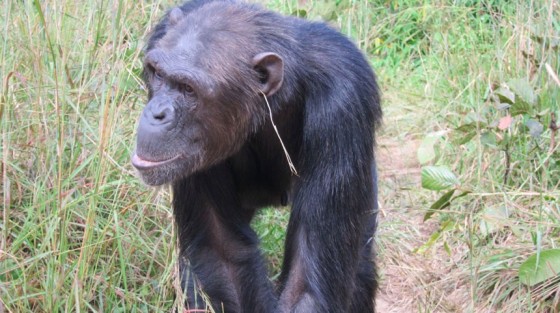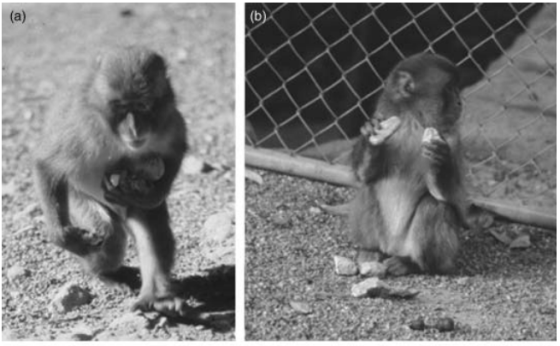1. In 2010, a female chimpanzee named Julie began repeatedly stuffing a stiff blade of grass into her ear. This Grass-in-ear behavior has affectionately been dubbed “GIEB” by the scientists who observed it.
2. Out of a group of twelve chimpanzees, eight engaged in GIEB. In three other groups of chimpanzees found in other locations in the same forest, only one was ever seen to GIEB.
3. The more that an individual associated with Julie, the more likely they were to GIEB.
4. After the inventor of GIEB died – if one could be said to invent a thing like putting grass in one’s ear – two chimpanzees continued to engage in the activity. They were never seen to do it together, let alone put grass in the other one’s ear.
5. A young monkey named Imo once noticed that her sweet potatoes were covered in sand and that if she dunked them in the water they would become clean. Within a few years, every monkey on her island was dunking sweet potatoes. She later learned that if she dunked them in the ocean instead, plunging them in after every bite, they would taste even better. The lesson? Monkeys love seasoned potatoes.
6. Some Japanese macaques like to play with stones, clicking and clacking them, rolling them along their hands, cuddling or pushing or throwing them. This was first invented by a young female monkey named Glance in 1979. Her playmates learned it first, followed by theirs. What began as transmission among friends has transformed into transmission among generations: now babies learn it from their mothers.
7. There are at least 11 mutations of this stone handling behavior, including “Rub With Hands”, “Grasp Walk”, and “Flinting”. These variations appear to be transmitted between tribes of monkeys when males migrate from one to another. Additionally, each generation appears to add complexity as each individual inadvertently contributes some new idea.
8. Monkeys are not the only animals with social transmission of ideas; many other animals do, though it may not necessarily be for the best. When young guppies are learning where to eat, they follow an older fellow to a source of food. Slowly, they learn from the older guppy which route to take to their food. As time goes on, one guppy learns from another and a route is set. However, this can be maladaptive when there is a faster route available: follow the group even if they know there is a quicker way.
9. One can digitize animals and ask how their theoretical equivalents toss around cultural traits. What causes these electronic cultures to die out? Simple: small groups, high mortality, poor transmission, and costly traits. Prestigious traits, or traits with group consensus, die out just as quickly as any other. In other words, a culture held in high esteem is just as mortal as any other.
10. The connections between members of a group aren’t uniformly random. Instead, they tend to form small worlds, where any two members are just a few steps away from each other. Thank you, Kevin Bacon. In any random network, as the set of connections reaches half the number of members, a “percolation” process causes many small groups to begin congealing into one large group. Much can be learned about sociality and culture using these ideas.
11. It is possible to classify social learning mechanisms in ten distinct ways: stimulus enhancement, local enhancement, observational conditioning, social enhancement of food preferences, response facilitation, social facilitation, contextual imitation, production imitation, observational response-stimulus learning, and emulation.
12. A computer tournament revealed that even indiscriminate copying is often better than trial and error learning. Copied individuals will often perform the best available behavior, and the better the behavior the more likely they were to survive. Thus, survival itself made behavior a non-random sample of the best behavior. Individuals were themselves highly useful filters of information waiting to be copied.
References
Huffman, M., Nahallage, C., & Leca, J. (2008). Cultured Monkeys: Social Learning Cast in Stones Current Directions in Psychological Science, 17 (6), 410-414 DOI: 10.1111/j.1467-8721.2008.00616.x
van Leeuwen, E., Cronin, K., & Haun, D. (2014). A group-specific arbitrary tradition in chimpanzees (Pan troglodytes) Animal Cognition DOI: 10.1007/s10071-014-0766-8
Laland, K., & Williams, K. (1998). Social transmission of maladaptive information in the guppy Behavioral Ecology, 9 (5), 493-499 DOI: 10.1093/beheco/9.5.493
Nunn, C., Thrall, P., Bartz, K., Dasgupta, T., & Boesch, C. (2009). Do transmission mechanisms or social systems drive cultural dynamics in socially structured populations? Animal Behaviour, 77 (6), 1515-1524 DOI: 10.1016/j.anbehav.2009.02.023
Stocker R, Green DG, & Newth D (2001). Consensus and cohesion in simulated social networks Journal of Artificial Societies and Social Simulation, 4 (4)
Rendell L, Fogarty L, Hoppitt WJ, Morgan TJ, Webster MM, & Laland KN (2011). Cognitive culture: theoretical and empirical insights into social learning strategies. Trends in cognitive sciences, 15 (2), 68-76 PMID: 21215677

